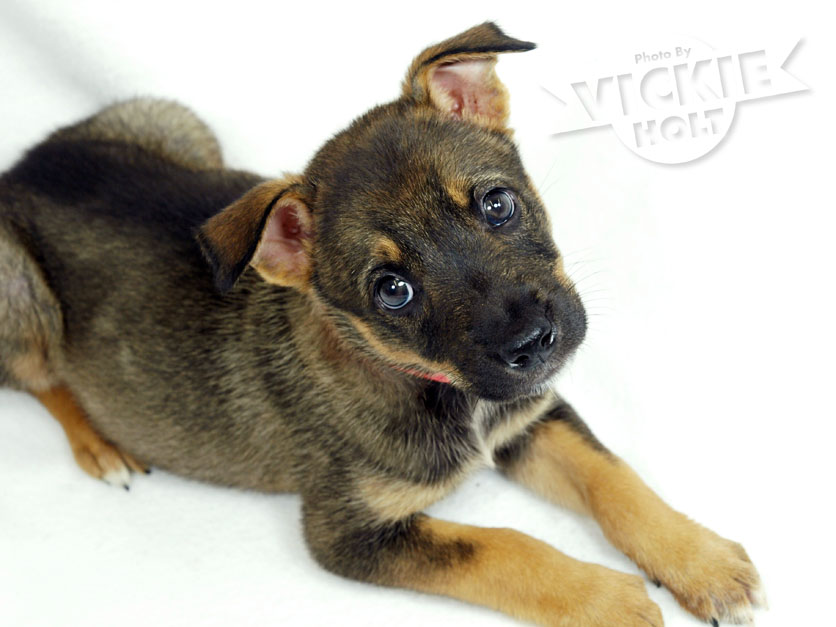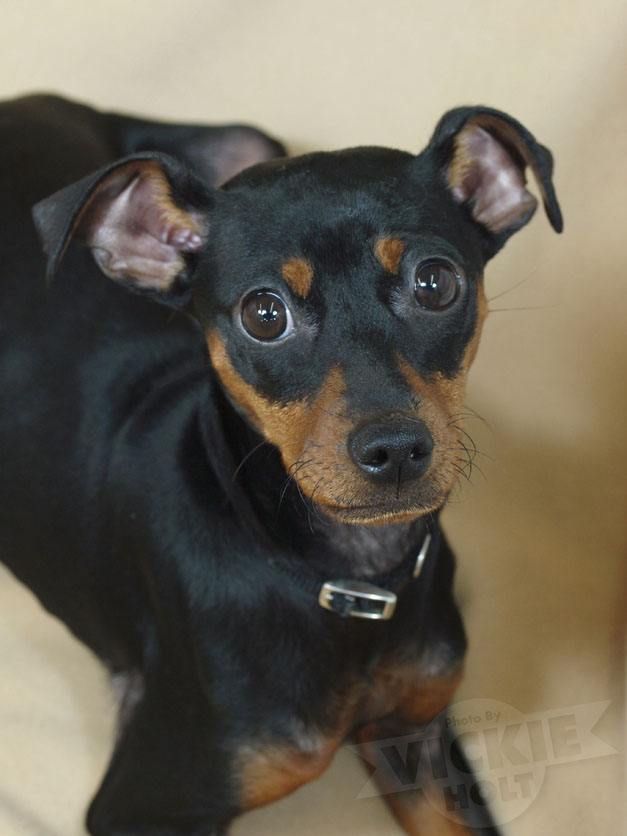The following post was written by Vickie Holt and provided to RescueGroups.org to help animal welfare organizations improve their adoptable animal photographs.
iPhone has recently aired a new commercial in which a fictional family uses their phone to search for a new dog online. The dog, Bailey, was found amongst hundreds of photos from dozens of shelters and lived happily ever after with her new forever family. This commercial illustrates the rapidly growing and widespread practice in this country of searching online first, and only going to a shelter after a picture is found that captures the searcher’s heart. Unfortunately, as Bailey’s photo in the commercial demonstrates, the nation’s shelters have not kept up with the times.
 If a shelter animal’s future happiness – and indeed, its life – depends on a single picture standing out amongst the hundreds a searcher might scan while online, then that photo has got to really shine and show the animal in the clearest and best manner possible. Unfortunately, the photographs found on most adoption websites fail in this respect. They show animals in cages, from above, with reflecting eyes and in dismal surroundings. How many animals have been passed over and euthanized when a better online photo may have united them with a loving home?
If a shelter animal’s future happiness – and indeed, its life – depends on a single picture standing out amongst the hundreds a searcher might scan while online, then that photo has got to really shine and show the animal in the clearest and best manner possible. Unfortunately, the photographs found on most adoption websites fail in this respect. They show animals in cages, from above, with reflecting eyes and in dismal surroundings. How many animals have been passed over and euthanized when a better online photo may have united them with a loving home?
Most shelters are non-profit and operate on a shoestring budget, and so most would not have the resources to hire a professional photographer. Most photos are taken by shelter staff with no photography training and no real time to devote to taking photo after photo to get a good one. Many shelters have not yet recognized just how important good photography is becoming, and so not much effort is made to improve. Everyone may find, however, that going forward, good photography is going to play an essential and indispensible role in any shelter or rescue organization’s efforts to find homes for their adoptable animals. Online shopping isn’t the future…it’s right now, and pets are no exception.
 My name is Vickie Holt, and I have had absolutely no photography training, yet I started taking photos for the Angels of Assisi adoption website in 2007. Since that time, the shelter’s adoption rates have skyrocketed, allowing them to not only adopt out their own animals, but to rescue and adopt out animals from other shelters in the eleventh hour before euthanasia, or worse. They have been able to save more lives than ever before. We have learned that Southwest Virginia keeps a close eye on the Angels of Assisi website, because applications pour in when new photos are added – depending on the animal, of course. There have even been comments from many in the public community stating that they view the site weekly, just to see the photos.
My name is Vickie Holt, and I have had absolutely no photography training, yet I started taking photos for the Angels of Assisi adoption website in 2007. Since that time, the shelter’s adoption rates have skyrocketed, allowing them to not only adopt out their own animals, but to rescue and adopt out animals from other shelters in the eleventh hour before euthanasia, or worse. They have been able to save more lives than ever before. We have learned that Southwest Virginia keeps a close eye on the Angels of Assisi website, because applications pour in when new photos are added – depending on the animal, of course. There have even been comments from many in the public community stating that they view the site weekly, just to see the photos.
With a modest camera and a few common and inexpensive tools, I have managed to create photos like these for almost every animal to come through Angels of Assisi in the last three years. I operate during the shelter’s normal business hours, amongst staff and visitors without getting in anyone’s way and without being interrupted, myself. Most photos are achieved within a matter of minutes with only moderate effort. I have learned a lot by trial and error, and have achieved better and better results through innovation, and now I’d like to share my experience and innovation with shelters across the nation. It’s my hope that, after learning a few methods and techniques, the staff in other shelters might also create pictures like these for their own websites so that even more little lives can be saved. Any shelter staff or volunteer can learn the tricks and techniques for easily taking pictures like the ones shown here. All these were taken inside the shelter, with little effort, and with easily obtained materials.
The first thing to consider when using photography as an adoption tool, of course, is the camera. Rule of thumb: if it fits in your pocket, don’t use it! It doesn’t have the features necessary to take these kinds of photographs. If the budget allows, go ahead and buy a SLR, but it is by no means necessary. There are many fixed-lens cameras on the market that mimic SLRs, but do not have interchangeable lenses. What they do have, however, are all the features necessary to take photos of all the different varieties and sizes of animal to be found in a shelter. Cameras such as the Canon PowerShot, Nikon Coolpix, Kodak EasyShare and the Sony Cybershot are all recommended. They can be found online, on Ebay or in your local department store for between $100 and $500. The investment may sound heavy, but when you think of the notoriety it can bring your shelter, and how many animals could be saved, it’s a meager sacrifice. You’ll also want to get a couple common shop lights, some white fleece from your local fabric store, a 100 gallon or more storage tub and a donated baby’s playpen. With these basic materials, anyone in any shelter can take photos that will have them lining up outside your door to adopt your animals.
It’s fairly easy to learn about the features on the camera, why they are used and how and when to use them during shelter photography. You can also learn handling tips for almost every kind of personality of cat, kitten, dog and puppy and what to do each time in order to get the great poses and expressions. These techniques, together with a little knowledge about lighting, setting and color, can help you to take great adoption photos using the interior and exterior of your shelter facility.
Here’s an example:
 This is Lady. She’s a min-pin I just photographed on April 25, 2010. She’s a small breed, so I used a little innovation I developed for photographing puppies and small breed dogs. I keep an old, donated baby’s playpen on hand. It has to be sturdy in order to withstand the weight and antics of small dogs. It’s best to find one with a metal frame and wooden bottom that folds away for storage. I set up the playpen and draped a solid color length of fleece from front to back, covering the bottom. On the front of the playpen, I clamped three shop lights, each with a 100 watt GE Energy Smart Daylight bulb. It must be the “daylight” bulb, which creates natural sunlight. Any other kind of bulb will cast a yellowish light that will ruin the photo.
This is Lady. She’s a min-pin I just photographed on April 25, 2010. She’s a small breed, so I used a little innovation I developed for photographing puppies and small breed dogs. I keep an old, donated baby’s playpen on hand. It has to be sturdy in order to withstand the weight and antics of small dogs. It’s best to find one with a metal frame and wooden bottom that folds away for storage. I set up the playpen and draped a solid color length of fleece from front to back, covering the bottom. On the front of the playpen, I clamped three shop lights, each with a 100 watt GE Energy Smart Daylight bulb. It must be the “daylight” bulb, which creates natural sunlight. Any other kind of bulb will cast a yellowish light that will ruin the photo.
Once the “studio” is set up, I simply placed Lady in the playpen and encouraged her to lie still and look at me. I did this by barking harshly at her to convey who was in command, then spoke in sweet tones and nudged her gently into a position lying down. I then continued to whine at her like a puppy to keep her attention on me while I took the shot (on macro setting) from the rim of the playpen. Taking the shot from the rim is important because it allows for a more face-on view of the dog, rather than a shot from above of an upturned nose. The whole thing, from setting up the studio, to finished shot, was about ten minutes. When compared to the picture of Bailey from the iPhone commercial – or indeed, to any of the shelter photos that can be seen during that commercial – it’s plain to see how Lady’s picture would easily stand out. A photo that stands out gets noticed, and a noticed shelter animal gets adopted.
The explanation of Lady’s photo is only an abbreviated slice of the methods I have learned and developed in my time at Angels of Assisi, and anyone else can learn to do the same for cats, kittens, small and large breed dogs, as well as that most challenging of all photography models…puppies.
Please join me in taking the next step in a revolution that will help animal shelters and rescue organizations maximize their efforts and save the lives of thousands of animals per year. The internet is the canvas. It’s up to us to paint the pictures that will change lives across the nation.
Please contact Vickie at vickieholt@cox.net for more information about learning to take great adoption photos in your own shelter.
See more of Vickie’s great animal photography in her galleries on Facebook.
* The opinions expressed in the blog post above are the views of the author and may not necessarily reflect the views and opinions of RescueGroups.org.